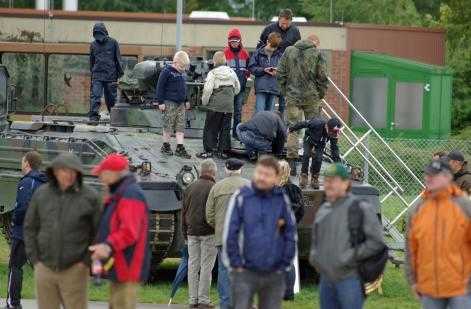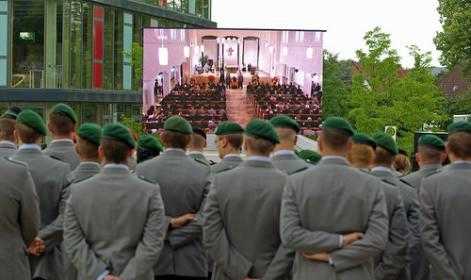Publicity campaigns: The German Armed Forces’ struggle for the hearts and minds of the population
Back to the Contents of the book
Michael Schulze von Glaßer
Small and ready to fight. In spite of a general reduction in personnel, the German Bundeswehr (Armed Forces) should in the future be more fit for action: 10,000 German soldiers should be able to be deployed abroad at any time, instead of the current 7,000.[1] But since the suspension of conscription, the Armed Forces have to meet their recruitment needs entirely by persuading volunteers to join up: 170,000 career soldiers, soldiers on contract, and reservists, plus up to 15,000 people doing voluntary military service. This calculation was presented by Minister of Defence Thomas de Maizière (Christian Democrats) in a policy speech in Berlin on 18 June 2011. At present, it does not seem to be a problem for the Armed Forces to find the 5,000 new recruits required every year. In the first year they were able to enlist 12,461 soldiers for voluntary military service.[2] However, one quarter of these left the Armed Forces shortly afterwards, leaving 9,400 new recruits. This number is, at least in the long run, probably too low.
But there is also another reason for the increasing public presence of the Armed Forces, articulated by the former president Horst Köhler (Christian Democrats) in an oft-quoted speech at the Armed Forces Commanders Conference in Bonn in 2005: 'The Germans trust their Armed Forces, and rightfully so, but real interest or even pride in it are rather rare. Even more rare is the wish and an attempt to understand and assess the changed foreign and security policy, which is impacting the German Bundeswehr. Of course we can name reasons for this friendly disinterest'.[3] Among the reasons for this 'friendly disinterest', Köhler cited the experience of World War II and the lack of a sense of threat. However, besides disinterest there is a stable majority within Germany which views German military operations abroad critically. For example, about 60% to 70% of the German population have opposed the deployment of the Armed Forces in Afghanistan for years and have demanded a fast withdrawal of German troops.[4] This means that whenever the German military presents itself in public, the polishing of its public image is a priority, so that in the future, they can go to war not just with the support of the German parliament, but also with the support of the German people.
In city centres
In 2006, acting on advice from the Bundeswehr Institute of Social Sciences, the Armed Forces created a new promotional unit called The Central Fairs and Event Marketing Department of the Armed Forces. Since then, they have been promoting enlistment as 'a career with a future.'[5] The flagship of this promotional unit is the so-called Career Meeting Point (KarriereTreff), consisting of three large trucks – the career truck, the cinema truck, and the equipment truck. These trucks tour all over Germany all year round visiting about forty cities, where they position themselves prominently in central places or at public events. The second tool of the unit is a large booth for fairs, which is used about fifty times every year, including at Gamescom, Europe’s largest video games fair, and at medical congresses, where it attempts to counteract its massive shortfall of medical personnel.
In addition to the Central Fairs and Event Marketing unit, all four regional military commands (North, East, South, and West) have their own Armed Forces Centres for Recruitment. Each of these units has two booths for fairs - similar to but smaller than that of Central Fairs and Event Marketing - and four smaller promotion trucks, which are used for career advice and the distribution of brochures. At almost all of the promotional events there are also military vehicles and equipment, such as tanks and helicopters.
Military ceremonies
The number of public military oath ceremonies outside military barracks has recently increased, especially under the leadership of former Minister of Defence Franz Josef Jung (Christian Democrats): there were 180 in 2009, as opposed to the 134 in 2007.[6] In 2008, the large military oath ceremony which is part of the annual public remembrance day for the attempted assassination of Adolf Hitler on 20 July 1944, was for the first time moved from the Bendlerblock (the Berlin seat of the Ministry of Defence) to the Reichstag, the German parliament.[7] In recent years, these ceremonies were transmitted live by the public TV broadcaster Phoenix.[8] Because the suspension of conscription also means a reduction in the number of new recruits, it is to be expected that the overall number of such ceremonies will go down – whether this reduction also includes public oath ceremonies, or only those held in military barracks, is currently unclear.
In addition, there are numerous traditional major military ceremonies (so-called 'grand tattoos'), which mark events such as a President or Minister of Defence standing down, which also might be shown live on television. In 2006 there were twenty, and in 2010 there were seven. More recently, the increasingly elaborate memorial services for soldiers killed in action are sometimes broadcast live by public TV channels, and the first award of the Armed Forces cross for a bravery medal in 2009 is a further indication of this establishment of a new cult of soldiering and heroism.[9] Shortly after the creation of the medal for bravery, a new Bundeswehr cenotaph was opened in Berlin, paying tribute to dead soldiers. Additionally, the eighteen Armed Forces bands, which together perform more than 3,000 concerts annually, play an important role in the promotion of a positive image for the military.
Advertising in the media
The Armed Forces spent €15 million from 2006 to 2009 on advertising in the print media, on the radio and in cinemas.[10] Between 2009 and 2011, the expenses for recruitment-related advertising alone have risen to more than €5.7 million per year. The Armed Forces regularly advertise in Germany’s largest school magazine, the Spiesser, with a circulation of more than one million.[11] In addition, their radio and cinema advertising targets young people, and focuses especially on recruiting new helicopter and fighter jet pilots. Finally, in spring 2010 and 2011, for the first time in years, they used television advertising. The twenty-second-long advertisement, which cost €189,000, directly promoted the use of weapon systems for: 'Mastering challenges, proving team spirit, mastering technology. Armed Forces – a career with a future', and later also with the slogan 'Armed Forces reform – Your opportunity'.[12] Presently there are two Armed Forces television advertisements, with the new promotional slogan: 'We. Serve. Germany.'
Militainment (military entertainment)
To improve its image even further, the Armed Forces also increasingly subsidise German film production: eleven in 2005, four in 2006, eight in 2007, twelve in 2008, and a record of twenty-two in 2009.[13] They provide film producers with large military equipment, the permission to film on military facilities, and even financial support. They especially support films, TV series, and documentaries which present them in a positive light.
In addition, the Armed Forces is increasingly involved in video games, possibly because it receives more international attention due to its operations abroad. Although as of yet they have only published a handful of browser-based games for recruitment purposes, neither they nor the Ministry of Defence object to their frequent portrayal in video games: indeed, the promotional effect is appreciated.
Conclusions and perspectives
The Armed Force’s presence in public spaces has grown markedly in recent years. Advertising in the media in particular should, according to the Ministry of Defence, be increased massively. In 2010, the Armed Forces opened their first recruitment office in the Saarbrücken central railway station, which could be seen as an attempt to be permanently present in the centres of large cities. Since the suspension of conscription, the district conscription boards are to be replaced by 'career centres' and 'career offices', but how this is going to be done – whether the present district conscription boards will also include a promotion and information unit, or whether they will be closed and promotional offices will be opened in city centres instead – is not yet known.[14] As long as the German government continues with an expansionist military policy undertaking global military operations, the promotion of the military on the 'home front' will increase too, until a sufficient number of soldiers are recruited and the German population has been made to accept war.
Notes
[1] Süddeutsche Zeitung, 'De Maizière erläutert Bundeswehrreform – Weniger Soldaten aber dafür mehr im Ausland', 27 May 2011. http://www.sueddeutsche.de/politik/de-maizire-erlaeutert-bundeswehrreform-hauptsache-kein-guttenberg-1.1102283 (accessed 23 August 2012).
[2] Süddeutsche Zeitung, 'Aktuelle Vorabmeldung: Soldatenüberschuss: die Bundeswehr ist für junge Leute attraktiver als man denkt', 5 July 2012. http://www.sueddeutsche.de (accessed 23 August 2012).
[3] Horst Köhler, 'Einsatz für Freiheit und Sicherheit', Rede von Bundespräsident Horst Köhler auf der Kommandeurtagung der Bundewehr, Bonn, 10 October 2005.
[4] Informationsstelle Militarisierung, 'IMI-Fact-Sheet Afghanistan: Das Drama in Zahlen', 28 October 2011. http://www.imi-online.de (accessed 23 August 2012).
[5] Michael Schulze von Glaßer, An der Heimatfront – Öffentlichkeitsarbeit und Nachwuchswerbung der Bundeswehr (Cologne, 2010).
[6] Bundestags-Drucksache 17/715.
[7] Andreas Müller, 'Feierliches Gelöbnis vor historischer Kulisse, 20 July 2008. http://www.bmvg.de (accessed 23 August 2012).
[8] Schulze von Glaßer, An der Heimatfront.
[9] Bundeswehr, 'Allgemeines: Die Ehrenzeichen der Bundeswehr', 10 January 2012. http://www.bundeswehr.de (accessed on 23 August 2012).
[10] Bundestags-Drucksache 16/14094.
[11] Michael Schulze von Glaßer, 'Armee umwirbt Kinder', 10 May 2009. http://www.telepolis.de (accessed 23 August 2012).
[12] Schulze von Glaßer, 'An der Heimatfront'.
[13] Bundestags-Druche 16/14094.
[14] Michael Schulze von Glaßer, 'Keine “Wehrpflicht”, dafür Karrierecenter', 5 December 2011. http://www.graswurzel.net (accessed 23 August 2012).
Translated from the original German by Richard Meakin


Add new comment